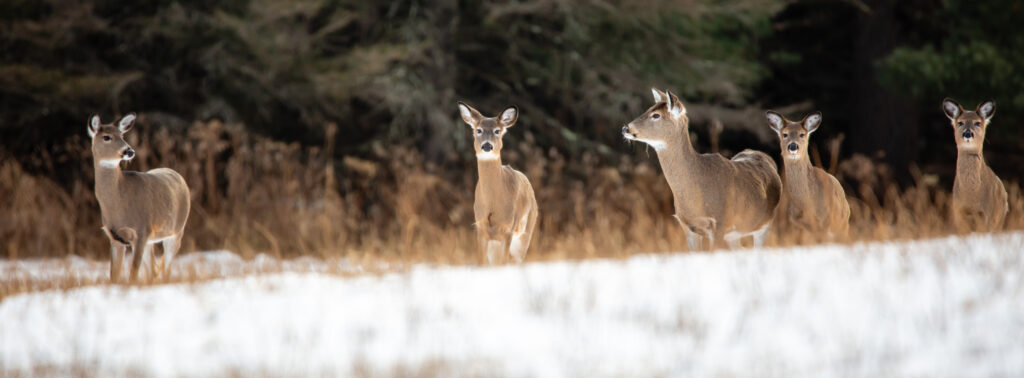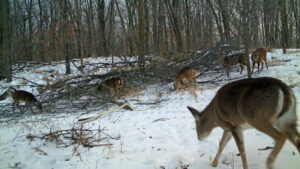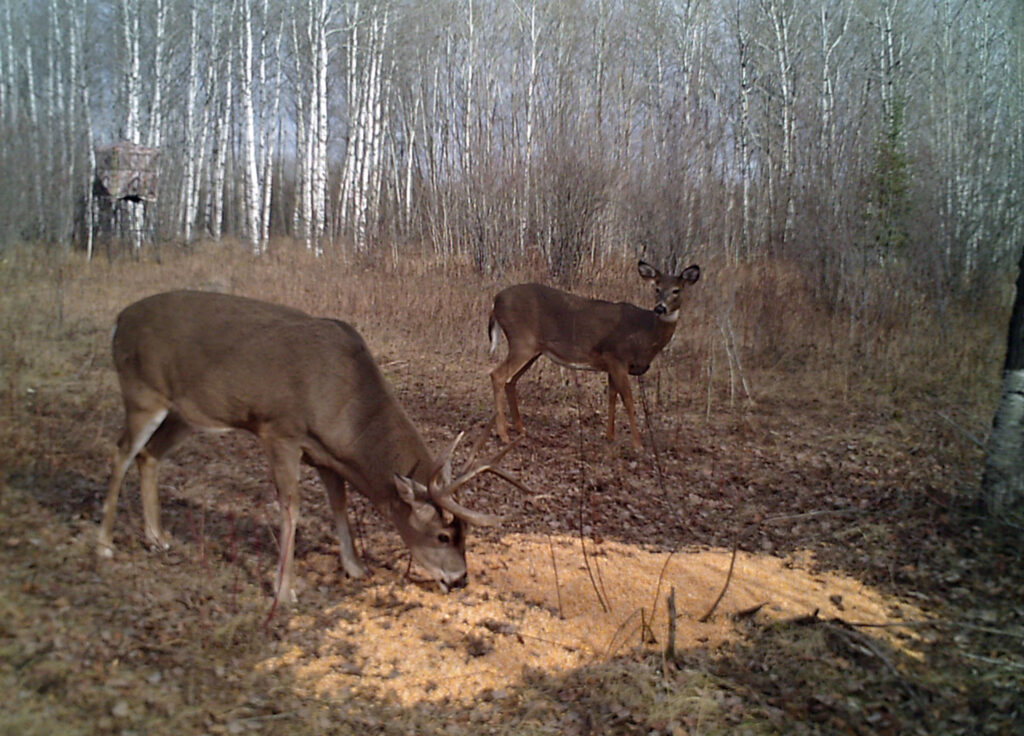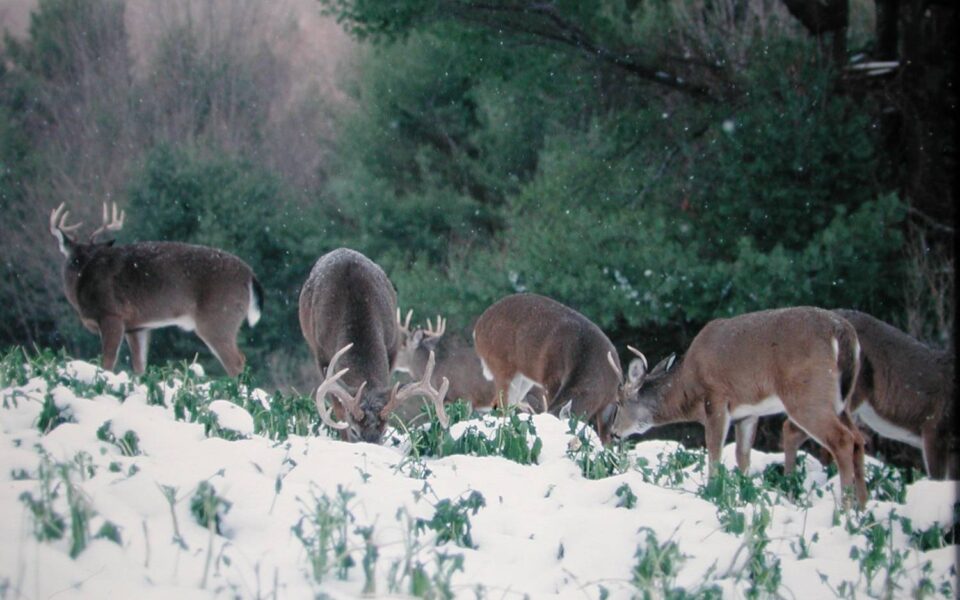Winter is a period of peril, when food is scarcest and least nutritious, and climatic conditions and selective pressures push deer to the brink of survival. Only the strong will make it, but that’s nature’s way of ensuring the herd and the species remain healthy. They’ve been doing it for eons and continually test the boundaries, expanding in range and number in mild winters and contracting in severe ones. Nature keeps them in check but we can sometimes offer a helping hand in getting them through the bottleneck of winter.

Michael Tatman
How Do Whitetails Do It
Whitetails have developed several different physical, physiological and behavioral strategies to make it through winter. One is larger body size. “Bergmann’s rule” states that “…within a broadly distributed taxonomic clade, populations and species of larger size are found in colder environments, while populations and species of smaller size are found in warmer regions.” It’s a strategy for energy conservation because larger animals actually have a lower “surface area to volume ratio” than smaller ones; so they radiate less body heat per unit of mass. That alone is often not enough.
Whitetails, like all animals, must constantly balance the cost: benefit ratio of energy. They must expend energy to feed, and thus take up more energy. When temperatures drop and snow piles up, it takes more energy to move. At some point, the cost exceeds the benefit. One way to avoid excess loss is simply to stop moving. Deer do move less in winter and may even “lay up” for extended periods of extreme cold, but eventually they’ll have to eat just to maintain body function.
Depending on geographic location, climate and the relative severity of a given winter (see sidebar: Winter Severity Index), the balance shifts and deer begin operating at a loss, not unlike many state governments, as energy costs exceed income. However, they’re prepared for this transition.

Biologists use kidney fat as an index of relative health
Some time back in late summer or early fall their diet shifted, from foods with high levels of protein they needed for growth and metabolic function to carbohydrates they can convert to build up winter fat. Anyone who has killed a big northern whitetail in early November has probably encountered this thick layer of tallow, especially around the belly and saddle.
As winter wears on, they burn more fat than they accumulate. First to go is external body fat, outside the body but under the skin. Next goes internal fat, like that around the kidneys. Biologists sometimes use a kidney fat index (KFI) as a measure of winter health. When all that is gone, they begin metabolizing fat from marrow. By cross sectioning the long bones of the legs, biologists can examine relative fat content in bone marrow. Light colored, waxy marrow indicates a deer still has healthy fat reserves. Red, gelatinous marrow is a sign of starvation.
It’s not that uncommon either. In addition to cold temperatures, deer also face a nutritional bottleneck as food is at its lowest point in abundance and nutrition. Bucks have a tougher time because they burn much of their fat during the rut. As soon as it’s over, they feed more aggressively trying to restore enough fat to carry them through the winter. Only the fittest will make it.
Whitetails Winter Coats
As summer wanes and the days grow shorter, deer experience another change that will better prepare them for the oncoming winter. Their reddish-brown summer coat, which consists of thin, solid hair, is gradually replaced with a winter coat of longer, thicker hollow hair. This helps insulate them so they lose less body heat. The hair is also darker so it absorbs more solar energy, further reducing heat loss.

Dave Medvecky
In addition to moving less, deer also adopt several other behavioral strategies to better balance the cost: benefit ratio. Especially in northern areas, they move from their regular seasonal haunts into deer wintering areas (DWAs) or “deeryards,” sometimes migrating long distances to reach them. Characteristics vary by region but they typically consist of dense softwoods that help cut the wind and reduce snow accumulation, reducing heat loss and allowing better mobility. The latter is important for both accessing food and avoiding predators. Prey animals sometimes experience safety in numbers, but large numbers of deer concentrated in small areas tend to attract more predators, somewhat negating that effect.
One DWA is good, but several are better as it reduces impact on the habitat. Just as important are travel corridors between DWAs as they allow deer to travel more efficiently and safely between feeding areas, and better avoid or elude predators.
How to Help
There are things a deer manager can do to improve winter survival, but the road to disaster is paved with good intentions. The best and perhaps most important step is ensuring the herd is maintained at a level the habitat can support. Conditions vary from one location to another but a general guideline for maintaining sustained yield is to keep the herd somewhere around 50 to 70% of carrying capacity. That ensures there will be enough natural food to carry the healthier individuals through the nutritional bottleneck.
Next comes cover. You should maintain or create enough dense winter cover so they’ll have shelter to survive severe winter conditions. That means softwoods (conifers). It also helps to have a diversity of age classes to preserve the canopy as older trees die off or are harvested. DWAs are often adjacent to, or near riparian areas where hardwoods provide the coarse, woody browse that makes up much of a whitetail’s winter diet. Periodic cutting can also help as hardwood stump sprouts are a great source of browse.
Food Plots for Success
Food plots can be a great source of winter nutrition, especially those like Biologic Winter Bulbs. Deer will mow down the greens in the fall, and then return in winter to feed on the root bulbs, often pawing and gnawing holes in the frozen ground to get at them. As the name implies, Biologic Winter Grass Plus is a great mixture of cool season cereal grains, Deer Radish and other brassicas that will persist well into winter, particularly in central and southern regions. The annual clovers and grains will also flush again the following spring to help deer recover more quickly.
Supplemental Feeding
Supplemental feeding seems like a good idea and many state agencies and local communities have implemented winter feeding programs over the years, with mixed results. Artificially concentrating deer outside of traditional wintering habitat is often a bad idea for several reasons. Deer don’t eat just the food provided. They still feed on natural vegetation and over time, it will become increasingly degraded. That’s bad for the deer and any local landowners interested in growing timber.

Artificial concentrations also attract predators and increase the potential for spread of diseases. As most folks aren’t willing to travel long distances to provide supplemental food, feed sites are often located close to roads, increasing car-deer collisions and other interactions between deer, humans and their pets. Deer chased by dogs use up valuable energy, reducing their health. Even deer-deer interactions increase stress and reduce fitness.
What, when and how you feed are also important. Corn is a popular deer feed but can be extremely dangerous if not provided properly. Deer have a complex digestive system and it takes time to develop the microbes necessary to digest high fiber food like woody browse. A sudden abundance of corn after that process has occurred could be detrimental to the deer’s digestive system – somewhat analogous to running a chain saw on pure gasoline – and deer could literally die of starvation with a full belly of corn. If you do feed corn, start early and don’t stop until well after green-up the following spring.
Predator Control
Reducing the number of predators on the landscape intuitively seems like a simple solution to improving deer survival, and it can be, sometimes. However, countless studies have shown repeatedly that it is extremely difficult to remove coyotes to a level that will have a measurable benefit. It generally takes intensive and prolonged effort and usually only has a temporary effect. Improving habitat and maintaining balance are more often a better approach.
Application
While all the above information is important for land managers, it can also be useful for hunters. Ask any outfitter from Prairie Provinces like Alberta and Saskatchewan and they’ll tell you the colder the temperature, the better the hunting. When the mercury drops below zero, or into the teens in Celsius, those big northern bucks need to feed to replace calories burned just from maintaining body temperature. And with long legs and heavy winter coats they’re well prepared to do so. Conversely, a deep cold down south might shut deer movement down temporarily as those deer don’t have the insulation, and it’s more energy efficient to sit and wait for warmer temperatures. A friend of mine who manages a property in central Alabama says he’ll wait until the sun melts the frost before going out.
If you’re hunting in the foothills or even the mountains in the deep cold, you’ll probably find more deer on the south facing slopes that receive more sunlight and less wind. In places like northern Maine and Minnesota, expect deer to be down in the softwood bottoms after a heavy snow. During the rut, you might concentrate on travel corridors but after, focus on food; that’s where depleted bucks will be going.
Conclusion
White-tailed deer are some of the most adaptable creatures on the planet. They have survived and often thrived for eons without assistance from humans, even as ice ages advanced and receded, and they’ll continue to do so. However, as we have irreparably changed the landscape, it behooves us to offer a helping hand where and when we can. In the absence or scarcity of large predators, we have to maintain herds in balance with their habitat. If we want more deer, we can improve habitat quality. However, you can’t stockpile deer. Each winter, some will make it and others won’t. A little struggle isn’t a bad thing as it ensures only the fittest individuals persist to pass on their genetic code for survival.








